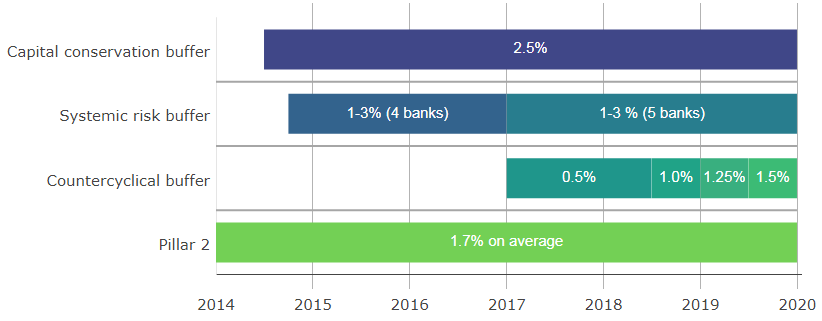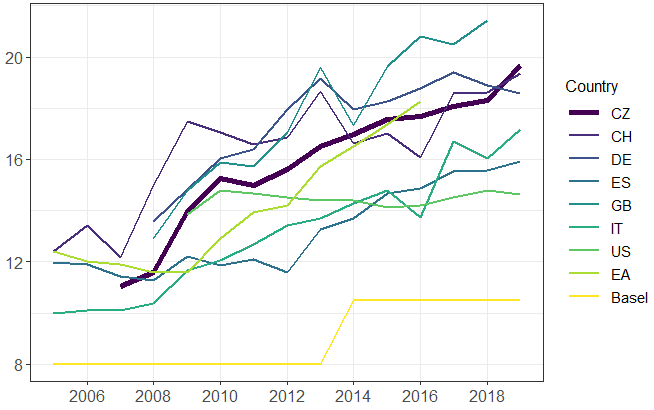Does increasing the stringency of capital regulation affect bank pricing policy?
In December 2010, the Basel Committee on Banking Supervision (BCBS) announced extensive reforms to strengthen the resilience of the financial system, reforms known as Basel III. Following the implementation of Basel III, the minimum capital requirements effectively rose from 8% to 10.5%,[1] and with all the additional buffers the capital requirements could exceed 20%. This enhanced the stability and resilience of banks. Over time, the debate surrounding the gradual implementation of Basel III became focused on the question of the costs associated with increasing the stringency of bank regulation. In this context, the results of a survey published by Ambrocio et al. (2020) are interesting. The authors show in their study that the vast majority of academic researchers believe than an increase in capital regulation would translate to a higher cost of bank lending. It is often the case that the costs of new regulation are ultimately borne by bank clients through increased rates on loans.
Does increasing the stringency of capital regulation affect bank pricing policy? This is one of the questions we answer in the Czech context in a new research paper titled Does Capital-Based Regulation Affect Bank Pricing Policy? The paper uses supervisory data on individual banking groups operating in the Czech Republic and estimates the effect of changes in the total capital requirements (Figure 1) on banks’ interest margins and lending and deposit rates.
Figure 1: Increases in overall capital requirements in the Czech banking sector over time

Source: Czech National Bank
Note: Pillar 2 represents the average across banks and quarters.
Our estimation results offer no evidence of changes in capital requirements being reflected in bank pricing policy. In other words, banks did not reflect the higher capital requirements observed in previous years in higher client rates on loans or lower interest rates on deposits. We conducted several robustness checks to verify our null results. The estimates are not statistically different from zero under any model specifications. We found no statistically significant effect for less-capitalised banks, which might be more sensitive to changes in capital requirements, not even when taking into account different time periods of the analysis. The changes in capital requirements had no significant effect on the price of new loans or the price of consumer credit.
Our findings contrast with the estimated effects of changes to capital-based regulation in other countries. The literature review in our paper shows that the point estimates reported in related studies abroad are small, ranging from 0 to 25 basis points.[2] These estimates seem to differ based on the characteristics of the banking sector and the choice of variables analysed. For example, there is a difference when studies analyse the effect of a change in the capital ratio (a bank’s total regulatory capital in relation to its risk exposures) or changes in capital requirements (only the capital requirement determined by the regulator for a bank in relation to its risk exposures). This is because the capital ratio may change for various reasons not necessarily related to a change in capital-based regulation.
We can interpret our results either as meaning either that the impacts of changes to capital requirements had a negligible effect on domestic banks’ funding costs, or that these banks responded to the changes in funding costs considerably less than predicted by foreign studies. According to our analysis, completely different factors, such as changes in market interest rates, changes in risk premia or changes in concentration in the sector, have a greater effect on the pricing policy of domestic banks. The fact that Czech banks operate with major capital surpluses and may thus not be motivated to pass these costs on to clients amid increasing capital requirements may not be the only explanation for the null impact identified. The average capital ratio of the Czech banking sector exceeds the minimum capital requirement dictated by Basel III to an extent which is not significantly higher than in other countries (see Figure 2).
Figure 2: The capital ratio by international comparison (in %)

Source: Financial Soundness Indicators, IMF.
Note: Basel represents the minimum capital requirements for banks introduced under the Basel II and Basel III reforms.
Our findings are in line with the argument that phased-in and announced increases in capital requirements enable banks to generate the necessary additional capital out of retained earnings instead of curbing lending to the economy (Kashyap et al., 2010). The macro- and microprudential policy of the Czech National Bank is conducted in a transparent manner. Its measures are communicated and announced well in advance and are thus expected by the market. This allows banks to prepare gradually and in time for the prepared future regulation. Capital management is a long-term process for a bank. If prudential policy measures were abrupt and unpredictable, banks would be forced to maintain a high level of capital for a long time to compensate for the unexpectedness of the regulator’s decisions. However, if regulatory measures are announced and communicated in advance, banks have no reason to change their pricing policy aggressively in response to the implementation of new regulation.
References
Ambrocio, G., I. Hasan, E. Jokivuolle, & K. Ristolainen (2020): “Are Bank Capital Requirements Optimally Set? Evidence from Researchers’ Views.” Bank of Finland Research Discussion Paper No. 10, Bank of Finland.
Birn, M., O. Debandt, S. Firestone, M. Gutiérez Girault, D. Hancock, T. Krogh, H. Mio, D. P. Morgan, A. Palvia, V. Scalone, et al. (2020): “The Costs and Benefits of Bank Capital — A Review of the Literature.” Journal of Risk and Financial Management 13(74).
Boissay, F., C. Cantú, S. Claessens, & A. Villegas (2019): “Impact of Financial Regulations: Insights from an Online Repository of Studies.” BIS Quarterly Review, March.
Kashyap, A. K., J. C. Stein, & S. Hanson (2010): “An Analysis of the Impact of ‘Substantially Heightened’ Capital Requirements on Large Financial Institutions.” Booth School of Business, University of Chicago, mimeo.
Martynova, N. (2015): “Effect of Bank Capital Requirements on Economic Growth: A Survey.” DNB Papers 467, Netherlands Central Bank, Research Department.
[1] 10.5% is the sum of the 8% minimum capital requirements and the 2.5% capital conservation buffer.
[2] Literature reviews are also provided in Martynova (2015), Boissay et al. (2019) and Birn et al. (2020).